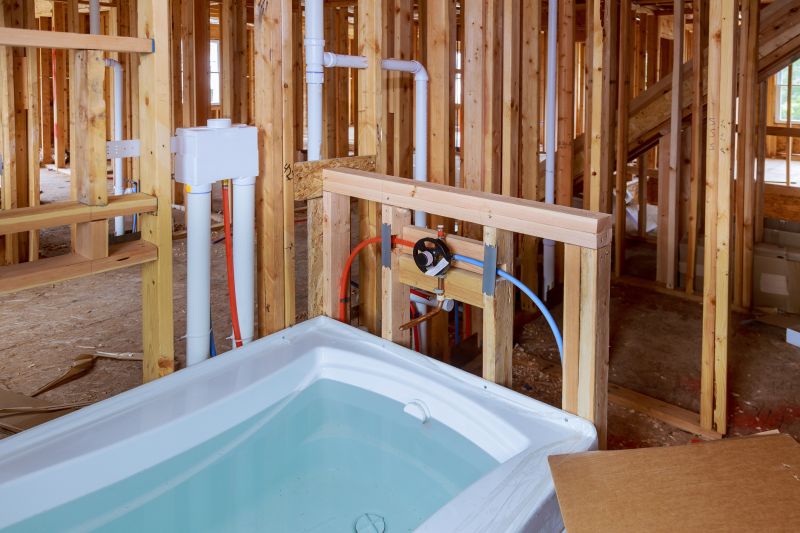Favorite Bathtub Installation Items For DIY Enthusiasts
Browse essential products that empower homeowners to undertake bathtub installation with confidence and precision.
 Installing a bathtub involves several considerations to ensure safety, durability, and aesthetic appeal. The selection of appropriate products can greatly influence the ease of installation and the longevity of the fixture. When planning a bathtub installation, it is essential to evaluate the space available, the plumbing connections, and the type of bathtub that best suits the intended use and style preferences. Modern options include various materials, shapes, and features that can complement different bathroom designs.
Installing a bathtub involves several considerations to ensure safety, durability, and aesthetic appeal. The selection of appropriate products can greatly influence the ease of installation and the longevity of the fixture. When planning a bathtub installation, it is essential to evaluate the space available, the plumbing connections, and the type of bathtub that best suits the intended use and style preferences. Modern options include various materials, shapes, and features that can complement different bathroom designs.
Top Overall Option
Universal Bathtub Installation Kit
A comprehensive installation kit that includes essential components such as waterproofing membranes, drain assemblies, mounting brackets, and sealing materials. Designed for versatility, it accommodates various bathtub sizes and types, making it suitable for both DIY enthusiasts and professional installers. The kit simplifies the installation process by providing all necessary parts in one package, ensuring compatibility and reducing the need for multiple purchases.
Types of Products For Bathtub Installations
Acrylic Bathtubs
Lightweight and easy to install, acrylic bathtubs are popular for their durability and variety of styles. They often feature smooth surfaces that are easy to clean and maintain.
Cast Iron Bathtubs
Known for their strength and longevity, cast iron bathtubs provide a classic look and excellent heat retention, though they are heavier and may require reinforced flooring.
Fiberglass Bathtubs
An affordable and lightweight option, fiberglass bathtubs are simple to install and repair, suitable for various bathroom sizes.
Corner Bathtubs
Designed to fit into corner spaces, these bathtubs maximize bathroom layout efficiency and often include additional features like jets or seating.
Whirlpool and Jetted Tubs
Equipped with hydrotherapy jets, these tubs offer relaxation options, requiring specialized plumbing and installation considerations.
Clawfoot Tubs
A vintage-style option that adds character to bathrooms, typically requiring standalone installation and support structures.
Walk-in Bathtubs
Designed for accessibility, these tubs feature low thresholds and easy-entry doors, suitable for users with mobility challenges.
Drop-in Bathtubs
Installed into a custom-built surround or deck, offering flexibility in design and materials.
Undermount Bathtubs
Integrated into the bathroom floor or platform for a seamless look, requiring precise installation techniques.
Freestanding Bathtubs
Stand-alone units that serve as focal points, available in various materials and styles for versatile placement.
Popular Choices
Widely favored for their lightweight construction and ease of maintenance, acrylic tubs are common in many bathroom remodels.
Known for durability and classic appeal, cast iron tubs are often chosen for their heat retention and longevity.
An economical choice with straightforward installation, fiberglass tubs are popular for budget-conscious projects.
Ideal for maximizing space, corner tubs are trending in compact bathroom designs.
Increasingly selected for accessibility features, walk-in tubs are gaining popularity among diverse user groups.
Their aesthetic versatility makes freestanding tubs a trendy choice for modern bathroom decor.
Offering hydrotherapy features, jetted tubs are common in luxury bathroom setups.
Flexible in design, drop-in tubs are frequently used in custom bathroom projects.
Providing a sleek, seamless appearance, undermount tubs are favored in contemporary designs.
Their vintage charm continues to appeal to those seeking a classic aesthetic.
Understanding the different components involved in bathtub installation can help in making informed decisions. These include the bathtub itself, the surrounding surround or tile, waterproofing materials, fixtures such as faucets and handles, and supporting accessories like drain assemblies and overflow covers. Proper installation not only enhances the visual appeal but also ensures safety and functionality over time.
In addition to the primary bathtub unit, accessories and supplementary products can improve the overall experience. For instance, grab bars, non-slip mats, and custom shelving can add convenience and safety. It is also important to consider the compatibility of these accessories with the chosen bathtub type and the existing bathroom infrastructure. Consulting with a professional or experienced supplier can help clarify the best options based on specific needs and space constraints.
Selecting quality products designed for bathtub installations can prevent common issues such as leaks, instability, or difficulty in maintenance. Investing in reliable, well-designed components contributes to a smoother installation process and a more satisfying long-term outcome. Whether renovating an existing bathroom or installing a new one, careful product selection ensures that the space will be both functional and visually appealing for years to come.
Key Buying Considerations
- Material durability and maintenance requirements
- Size and capacity to fit your bathroom space
- Weight of the bathtub and floor reinforcement needs
- Type of installation (drop-in, freestanding, alcove, corner, etc.)
- Compatibility with existing plumbing fixtures
- Accessibility features or modifications needed
- Aesthetic style and finish options
- Availability of warranty or support
- Ease of cleaning and long-term upkeep
- Budget constraints and overall project costs
- Additional features such as jets, massagers, or ergonomic design
- Sound insulation and vibration considerations
- Compatibility with waterproofing and sealing materials
- Installation complexity and whether professional help is required
- Environmental conditions such as humidity and ventilation
